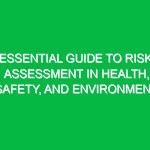Welcome, team! Today, we’re going to discuss a crucial topic that directly impacts our safety on the road – Fatigue on the Roadways. As we all know, driving while fatigued can lead to serious accidents and jeopardize not only our safety but also the safety of others on the road. It’s essential that we understand the risks associated with fatigue and learn how to combat it effectively for a safer journey.
The Impact of Fatigue on the Roadways
Fatigue on the roadways is a significant concern within the Health, Safety, and Environment (HSE) domain. When drivers are fatigued, their reaction times are slowed, their decision-making abilities are impaired, and they are more prone to making mistakes. This can result in accidents, injuries, and even fatalities. It’s crucial that we recognize the signs of fatigue and take steps to combat it before getting behind the wheel.
Recognizing the Signs of Fatigue
It’s essential to be able to recognize the signs of fatigue in ourselves and our colleagues. Some common signs include yawning, heavy eyelids, drifting between lanes, missing exits or traffic signs, and feeling irritable or restless. If you notice these signs in yourself or others, it’s important to address them immediately and take steps to combat fatigue.
Combatting Fatigue on the Roadways
There are several strategies we can employ to combat fatigue and ensure a safer journey on the road. These include getting an adequate amount of sleep before driving, taking regular breaks during long journeys, staying hydrated, and avoiding heavy meals before driving. It’s also important to avoid driving during times when you would normally be sleeping, as this can increase the risk of fatigue.
Real-Life Example:
Imagine you have a long journey ahead of you for a work-related trip. You’ve had a busy week and didn’t get much sleep the night before. As you start driving, you begin to feel drowsy and find it challenging to focus on the road. This is a clear sign of fatigue, and it’s essential that you pull over, take a break, and rest before continuing your journey.
Best Practices for Combatting Fatigue
Implementing best practices for combatting fatigue on the roadways is essential for maintaining a safe working environment. By following these practices, we can reduce the risk of accidents and ensure the safety of ourselves and others on the road.
- Get an adequate amount of sleep before driving.
- Take regular breaks during long journeys to rest and refresh.
- Avoid driving during times when you would normally be sleeping.
- Stay hydrated and avoid heavy meals before driving.
Regulations and Standards
It’s important to be aware of any regulations, standards, or company policies related to fatigue on the roadways. Compliance with these regulations not only ensures our safety but also helps us meet legal obligations and maintain a safe working environment.
Conclusion
In conclusion, combatting fatigue on the roadways is essential for ensuring a safer journey for ourselves and others. By recognizing the signs of fatigue, implementing best practices, and staying compliant with regulations, we can reduce the risk of accidents and promote a culture of safety on the road. Remember, safety is everyone’s responsibility, and by working together, we can create a safer working environment for all.
Thank you for your attention and commitment to safety. Stay safe on the road!


